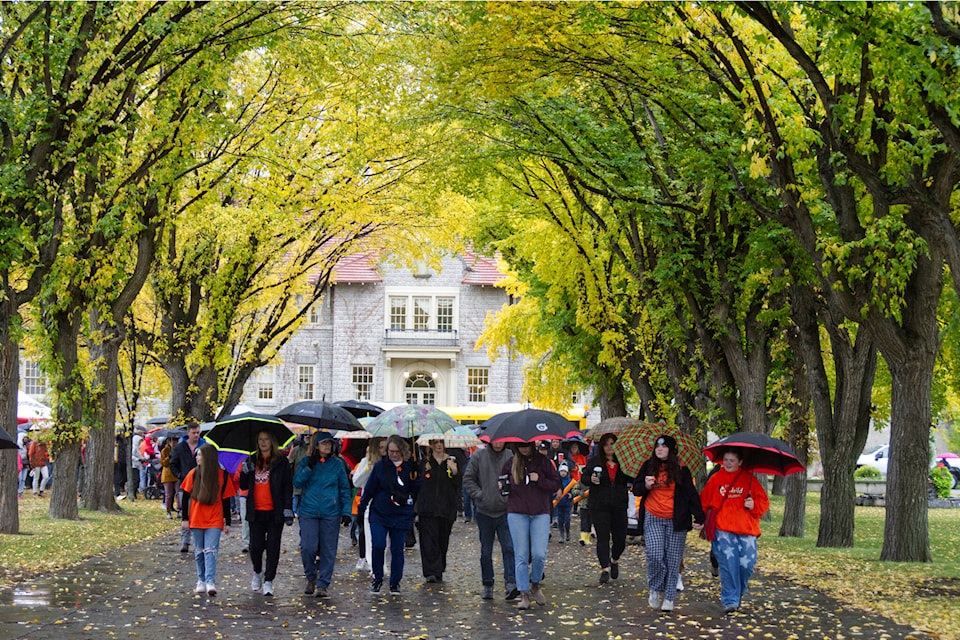Hundreds of ʔaq̓am community residents, Ktunaxa Nation citizens and guests joined together for a meaningful hike during a rainy Saturday (Sept. 30) morning to mark the National Day for Truth and Reconciliation.
The walk began and ended at the St. Eugene resort, formerly the Kootenay Indian Residential School, and stopped midway at a viewpoint on a ridge above the ʔaq̓am community known as Crying Hill. It’s there Ktunaxa and Indigenous children forced to attend the school would first get an unobstructed glimpse of the building.
At the top of the hill, residential school survivors were recognized and honoured, and given an opportunity to speak. Some offered snapshots of memories in the residential school system, as themes of resiliency, strength and healing threaded through those shared experiences.
Sophie Pierre was a student at the residential school from 1956 to 1963.
“I think that many of you that are here, you know why we are here and you know why this is called Crying Hill,” she told the crowd. “And as you turn around on your journey back down the hill, you’ll see why, because you get a beautiful view of the valley and a very clear view of the former residential school.”
As people gathered in the rain at the St. Eugene Golf Resort and Casino, ʔaq̓am Nasuʔkin (Chief) Joe Pierre Jr. welcomed everyone, before prayers and Sookenai Singers sent everyone off in a good way.
Formerly known under the colonial governance system as the St. Mary’s Indian Reserve, Pierre told the gathering that not long ago, the community went through the legal process to reclaim it’s identity as ʔaq̓am — the place of the pines — as it is translated from the Ktunaxa language.
George Heyman, the B.C. Minster of Environment and Climate Change Strategy, was also in attendance.
“There are so many different areas that we learn about every day to bring people closer together to respect and recognize the history, the culture, the traditions, the rights and titles of Nations around what we call British Columbia,” Heyman said.
“And a day like today, in a setting like this, is a place where we can acknowledge and recognize the horrors of the past and come together and learn how we can respect each others’ differences and respect what we have in common and join together to build a much, much different and better future for all of us.”
Kootenay East MLA Tom Shypitka also gave a brief address, noting that the B.C. Legislature is committed to reconciliation while recognizing the importance of observation, wisdom and being educated about the the legacy of the residential school system.
The walk was saturated with the colour orange, representing the story of Phyllis Webstad, a Stswecem’c Xgat’tem First Nation citizen whose new orange shirt was taken away from her by Saint Joseph Mission Residential School staff when she was sent there at six years old in 1973.
Webstad’s story is the inspiration behind the Orange Shirt Society and Orange Shirt Day, which raises awareness on the inter-generational impacts of the residential school system’s legacy and encourages and supports reconciliation activities and events.
While known now as the St. Eugene Golf Resort and Casino, the building historically was the Kootenay Indian Residential School, which opened in 1912 with funding from the Canadian government, according to the resort’s website.
It operated as a farm school, first by the Sisters of Providence until 1929, and then by the Sisters of Charity of Halifax in 1936, who remained until the school closed in 1970.
It was flooded and abandoned for over 20 years until the Ktunaxa developed a vision to reclaim the building and transform it into a resort. That journey began to take shape in 1992, after all Ktunaxa Nation bands approved a referendum to restore the building.
The St. Eugene Golf Resort and Casino, which fully opened in 2003 after 10 years of restoration, is now wholly owned by the four Canadian Ktunaxa bands and the Shuswap Indian Band.
The resort features an 18-hole golf course, a casino, an RV park, and also includes the Ktunaxa Interpretive Centre and offers cultural services such as Indigenous Culture Awareness Training.
After the walk on Saturday concluded, the Dan Joe Memorial Gymnasium hosted a traditional powwow, as Nasuʔkin Pierre led the Grand Entry with dignitaries and representatives from other Nations, while drums and voices joined in song echoed through the air.
Residential school survivors were introduced and honoured and, later, guests seated in rows along the walls of the gymnasium were encouraged to join in for social dances and make new friends.
A National Day for Truth and Reconciliation was one recommendation from 94 calls to action that came out of the Truth and Reconciliation Commission headed by the late Senator Murray Sinclair, who was the first Indigenous judge appointed to the Manitoba bench in 1988.
The 94 calls to action were issued at the conclusion of the commission’s work in 2015, which range from language and culture, health, education, justice and youth programming, among many others.
The National Centre for Truth and Reconciliation continues the work conducted by the commission, which stewards residential school survivor statements, documents and other materials collected through the commission’s work.
trevor.crawley@cranbrooktownsman.com
Sign up for the Cranbrook Townsman’s newsletter here to have local stories delivered straight to your inbox every morning.
